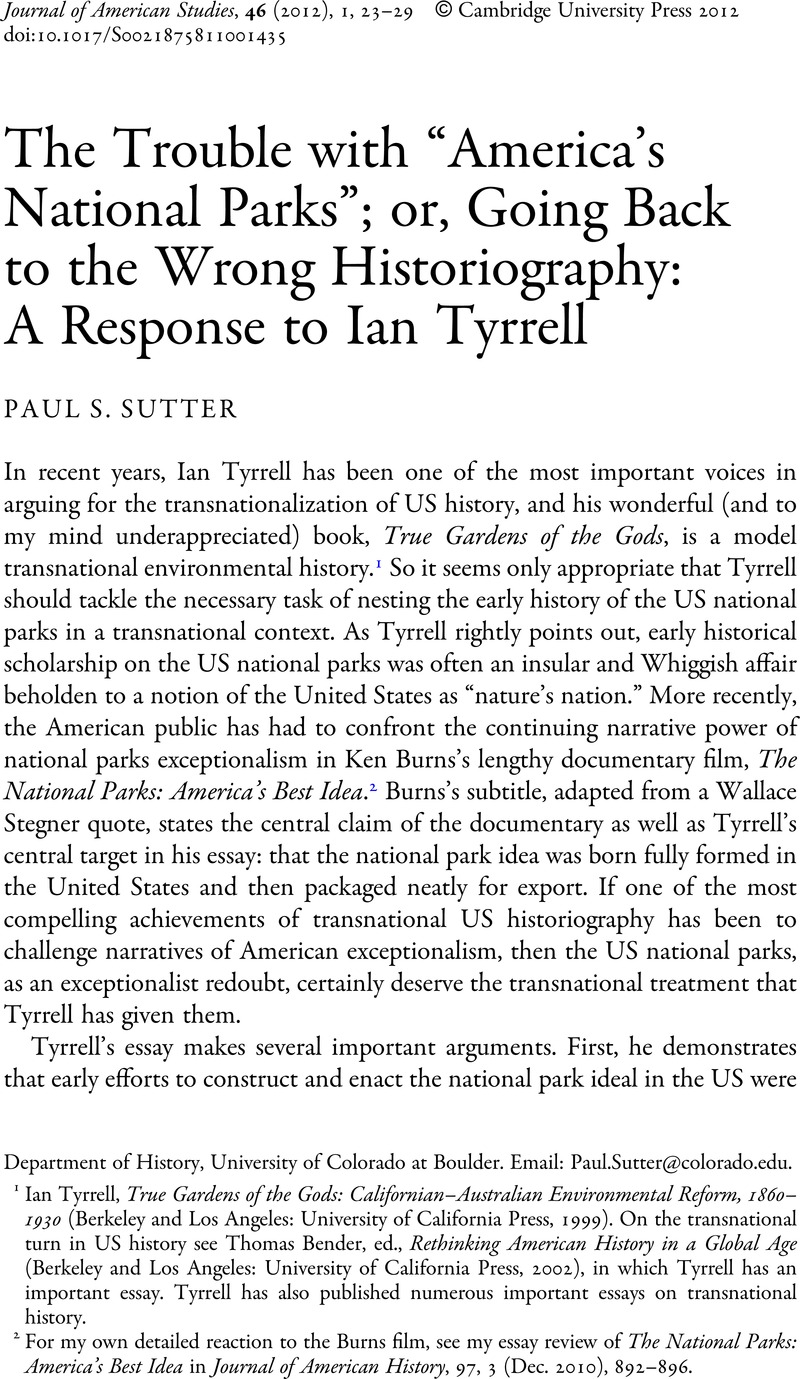Article contents
The Trouble with “America's National Parks”; or, Going Back to the Wrong Historiography: A Response to Ian Tyrrell
Published online by Cambridge University Press: 09 March 2012
Abstract

- Type
- Research Article
- Information
- Copyright
- Copyright © Cambridge University Press 2012
References
1 Tyrrell, Ian, True Gardens of the Gods: Californian–Australian Environmental Reform, 1860–1930 (Berkeley and Los Angeles: University of California Press, 1999)Google Scholar. On the transnational turn in US history see Bender, Thomas, ed., Rethinking American History in a Global Age (Berkeley and Los Angeles: University of California Press, 2002)CrossRefGoogle Scholar, in which Tyrrell has an important essay. Tyrrell has also published numerous important essays on transnational history.
2 For my own detailed reaction to the Burns film, see my essay review of The National Parks: America's Best Idea in Journal of American History, 97, 3 (Dec. 2010), 892–896.
3 Sellars, Richard West, Preserving Nature in the National Parks: A History (New Haven: Yale University Press, 1999)Google Scholar.
4 There are signs that the national parks, too, are starting to get the transnational treatment Tyrrell advocates. The best example of this was a recent conference at Colorado State University on National Parks beyond the Nation. For more on that gathering see http://nationalparksbeyondthenation.wordpress.com.
5 Two recent biographers of John Muir and Gifford Pinchot, the major characters in the Hetch Hetchy drama, both recognize the complexity of their thought and how each was more than an avatar for a single-minded environmental worldview. See Worster, Donald, A Passion for Nature: The Life of John Muir (New York: Oxford University Press, 2008)Google Scholar; and Miller, Char, Gifford Pinchot and the Making of Modern Environmentalism (Washington, DC: Island Press, 2001)Google Scholar.
6 See, for instance, Barton, Gregory, Empire Forestry and the Origins of Environmentalism (New York: Cambridge University Press, 2002)CrossRefGoogle Scholar; Sachs, Aaron, The Humboldt Current: Nineteenth-Century Exploration and the Roots of American Environmentalism (New York: Viking, 2006)Google Scholar.
7 On “See America First,” see Shaffer, Marguerite, See America First: Tourism and National Identity, 1880–1940 (Washington, DC: Smithsonian Institution Press, 2001)Google Scholar.
8 See Sutter, Paul S., Driven Wild: How the Fight against Automobiles Launched the Modern Wilderness Movement (Seattle: University of Washington Press, 2002)Google Scholar.
9 Miles, John, Wilderness in National Parks: Playground or Preserve (Seattle: University of Washington Press, 2009)Google Scholar.
10 Several years ago, sensing that we desperately needed an updated history of the wilderness idea in the US, Michael Lewis edited the important volume American Wilderness: A New History (New York: Cambridge University Press, 2007)Google Scholar.
11 There is a growing literature on postwar US development, though to date the national park ideal has received little attention within it. See Cullather, Nicholas, Feeding a Hungry World: America's Cold War Battle against Poverty in Asia (Cambridge, MA: Harvard University Press, 2010)Google Scholar; Ekbladh, David, Modernization and the Construction of an American World Order (Princeton: Princeton University Press, 2010)Google Scholar; Staples, Amy L. S., The Birth of Development: How the World Bank, Food and Agriculture Organization, and World Health Organization Changed the World, 1945–1965 (Kent, OH: Kent State University Press, 2006)CrossRefGoogle Scholar.
12 Rodgers, Daniel T., Age of Fracture (Cambridge, MA: Harvard University Press, 2011)Google Scholar.
- 1
- Cited by


